Elizabeth Stewart's Blog
October 7, 2025
Lady’s Stirrups Silver or Not?
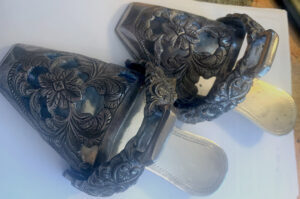 PS asked about a pair of silver stirrups, necessary for riding a horse. Imagine a time before cars in our world, and we rode horses—or they pulled us. For thousands of years we’ve recognized stirrups as form. PS wonders if her pair of stirrups are decorative or if a lady equestrian used them. When? Where?
PS asked about a pair of silver stirrups, necessary for riding a horse. Imagine a time before cars in our world, and we rode horses—or they pulled us. For thousands of years we’ve recognized stirrups as form. PS wonders if her pair of stirrups are decorative or if a lady equestrian used them. When? Where?
These are South American stirrups, dating from the early 19th century. They’re SO SMALL that I, too, suspect they’re lady’s stirrups, from a time when women prized dainty feet. A lady used them in 1820 or there abouts. At this time, when these stirrups came into the world, most women had on an average of five kids. Who’s feet remained SMALL after carrying such a load?
Let’s see how universal stirrups were in the 19th and 18th centuries, and how plentiful the relics of them ARE. Few stirrups are worth much in the marketplace as “equipage,” a word meaning objects related to carriage via horse or horseback. That market is strong and active.
Firstly, let’s look at the ‘’encased foot’ form of stirrup. Spanish Colonial riding stirrup from the late 18th century, with a curved toe, echo the Moorish heritage of Spain. An ornate element, a beautiful, foliated band with a small slot attaches to the saddle. Those only set you back around $300 for an antique pair, because many existed. In Old Spain they copied silver stirrups from the Moorish SOLID BRASS stirrups. In New Spain, of which our California belonged to, one found stirrups much the same.
Stirrups From Other CountriesJapanese stirrups of the late 19th century, called “Abumi” are also small, but in a “C” shape. They don’t encasing the foot, but rests the foot on the bottom of that “C” shape. Beautiful in their simplicity. These are made in bronze and brass and worth $1,500. If you find a pair of Abumi cast in iron with a beautiful gold-gilt inlay, you have something valuable. I bet you think they’re modern abstract works of art, and you might never recognize they’re stirrups from the 19th century. They’re so beautiful you cannot imagine feet perched in them as a rider must do on horseback. In a wonderful curve in a C shape from the Meiji period 1868-1911, they sell for upwards of $2,000 the pair.
Something more recognizable is the American Old West stirrup, functional and still used in original form today, also with Spanish influence. An interesting sideline for collectors of “equipage,” some American stirrups created to support political candidates! Thus, in America of the 19th century, stirrups supported something other than the FOOT.
A case in point are the stirrups made for the candidacy of Henry Clay, the Speaker of the House who ran in the 1844 Presidential Campaign. He loved horses. From the State of Kentucky he bred horses, so his campaign created stirrups with an initial band which read ‘HCLAY,’ on which you might rest your feet.
Henry Clay lost his bid for the presidency. But he raised a famous racehorse, the greatest horse of the 19th century, the sire of America’s National Thoroughbred Trotting Horse. The horse’s progeny became the magnificent “Clay Line” of great trotting horses. The horse passed away peacefully in 1867. Named after human political candidate Henry Clay, the horse was exhumed, and his mandible put on display at the Smithsonian Institute in Washington DC.
Silver or Not?PS, your stirrups aren’t sterling at all. Sterling contains a great deal of pure silver. Your South American stirrups are made of Brazilian Britannica Metal, not containing much silver content at all, in the style of Conquistador Stirrups from the third quarter 19th century, made for a lady rider with flouncy gowns to match these stirrups.
The great Brazilian “equipage” ironmonger Correa de Lima, of Rio de Janeiro (1861-1873) made the best of these South American lady’s stirrups. A similar pair sold at New Orleans Auctions for $300.
The post Lady’s Stirrups Silver or Not? appeared first on Elizabeth Appraisals.
October 5, 2025
The Impressionist Revolution and Encore
Art historian and storyteller Brigette Ginter talks about The Impressionist Revolution and Encore exhibits at the Santa Barbara Museum of Art through January 25, 2026.
Watch Video

The post The Impressionist Revolution and Encore appeared first on Elizabeth Appraisals.
September 30, 2025
William “Bill” Shinn: Master of Ceramic Extrusion Techniques
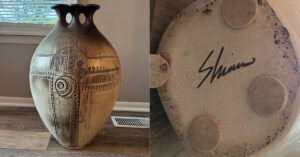 MC inherited a pottery floor vase, a quirky work from the mid-1970s by genius Santa Maria potter, William “Bill” Shinn (1932-2011). Did Shinn get inspiration for the design from a native American marriage vessel, typically with two spouts? Wait, I see THREE spouts! I believe the artist meant something for OUR times as well as his: love is many-fold.
MC inherited a pottery floor vase, a quirky work from the mid-1970s by genius Santa Maria potter, William “Bill” Shinn (1932-2011). Did Shinn get inspiration for the design from a native American marriage vessel, typically with two spouts? Wait, I see THREE spouts! I believe the artist meant something for OUR times as well as his: love is many-fold.
The artist himself, an intrepid researcher, traversed the American desert, as well as Europe, Japan, and Russia in search of inspiration. Shinn, an internationally recognized potter and teacher, won awards at international ceramic competitions in Italy, New Zealand, and Korea. He received a master’s in Ceramic Design at UCLA during a seminal period in ceramic arts, and the Sorbonne and Academie Julian in Paris. To great acclaim as a young artist, he exhibited at the Syracuse Nationals in1966. The Everson Museum in Syracuse collected his work for their permanent collection.
After the Artist Died in 2011Many of his former students at Allan Hancock College missed his personal instruction in his own studio in Santa Maria. There, he experimented, and became a master of ceramic extrusion techniques using a distinctive machine to aid the creation of three-dimensional work. Die cuts created to extrude large hollow forms.
In the December 2002 edition of Ceramics Monthly, Shinn said, “The extruder is an ideal tool for sculpture, both abstract and representational…dies created specifically for this purpose can produce work that can be easily bent, twisted, and joined together.” Today three-D printers create dies.
Shinn combined both extrusion and slab form creations in his unique oeuvre. Imagine forcing clay through a tube, you get the idea. Think of forcing clay through a tube with a cookie cutter imbedded inside. If you ever attempted to hand roll a coil pot, you’d love to use an extruder. it creates even and unbroken strings of coils. But the tool does much more. Shinn pushed the boundaries, as you see from MC’s three-spouted work.
Studio Art Pottery MovemenThis style puts Shinn in the annals of the American Studio Art Pottery Movement right at its most formative time. Earthy, massive forms of the midcentury and the distinctive glazes, sometimes earth tones, sometimes 1960s vibrant colors, are HOT property TODAY. We find not only vessels but ceramic sculpture. Shinn was a master of large ceramic sculpture pieces like this one, owned by MC. She wants to sell by the way.
I love the small spouts and VERY bulbous “shoulder,” the round part of the top of the vase. Vasefinder Auctions lists of a smaller less “design-y” vase for $60, and Ross’s Auction in Belfast sold a complex designed vessel for $350. Ist Dibs sold a Shinn abstract sculpture vase for $800.
Judith Hale Gallery Solvang/Santa Ynez represented the artist for years. Currently from a gallery in Pasadena, I found a large ovoid vessel, raised on a round plinth in a deep brown glaze. At the center of the oval is a patterned round circle incised in deep relief, offered for $825. One of the great looks of this genre is the anthropomorphic shapes, as well as borrowed design motifs from the Japanese and the Native American.
How Did Shinn Find Clay?How did the artist, who began with painting, find “clay?” He served as a fighter pilot in the Air Force, and found “sculpture” in the forms beneath his plane. An article in the June 9, 2009, issues of the Santa Maria Sun by Shelley Cone quotes Bill Shinn, “There are a lot of things that suppress being creative. The main motivation for me is creating something I’ve never seen before.”
Cone asked Shinn about his many awards, sales, and shows, as a possible influence on what he creates in the studio. But the answer came in Shinn’s obituary in the Santa Maria Times from a former student who became an instructor at Allan Hancock, Marti Fast. Regarding the push-pull of creativity versus market influence on an artist’s work, Fast said of Shinn, “His mind worked differently because he wasn’t worried about a specific outcome.”
MC’s vase is worth $800 in this fast growing American art pottery of the mid-20th century marketplace.
The post William “Bill” Shinn: Master of Ceramic Extrusion Techniques appeared first on Elizabeth Appraisals.
September 29, 2025
News From the Art World
Santa Barbara appraiser Elizabeth Stewart talks about the latest art news, including a Van Gogh—real or not?
Watch Video

The post News From the Art World appeared first on Elizabeth Appraisals.
September 21, 2025
Redwoods of the Sea
Photographer Ralph A. Clevenger and Curator Emily Falke discuss the Redwoods of the Sea: Life in the Channel Islands Kelp Forests exhibit at the Santa Barbara Maritime Museum through January 4, 2026.
Watch Video

The post Redwoods of the Sea appeared first on Elizabeth Appraisals.
September 16, 2025
Common American Washboard
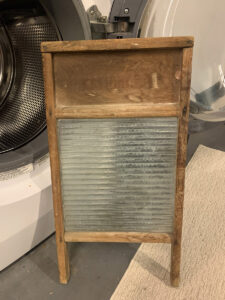 Why did people use washbats, a washboard, washbox, washing dollies, peggylegs, possers, posssticks, dollypegs, peggy, maiden, plunger, ponches, and punchers? They used these to wash clothes with or without a washtub. Sometimes they used them at the edge of a stream, inside a public washhouse, off a boat, or in the public fountain.
Why did people use washbats, a washboard, washbox, washing dollies, peggylegs, possers, posssticks, dollypegs, peggy, maiden, plunger, ponches, and punchers? They used these to wash clothes with or without a washtub. Sometimes they used them at the edge of a stream, inside a public washhouse, off a boat, or in the public fountain.
JE owns an early 20th century washboard, the American cousin of the objects listed above. In use by 1860s across the nation but invented in 1833 by Stephen Rust of New York, who patented a wood frame that held a fluted piece of tin, iron, or zinc. These ridges dislodged dirt from clothing. Advertisements for these ran in the mid-19th century. By the later part of the 1800s Herman Liebmann “improved” the boards. This Chicago man replaced the metal plate insert in the board with ridged glass or porcelain. This is the version in JE’s garage.
Laundry Day OrdealFor years specialist washerwomen performed this task if the family afforded such help. In many parts of the world getting clothes and linens clean happened once a week, or once a month, or once a year depending on the item. Usually the day fell on MONDAY, especially in those traditionally Catholic countries. In many cases it took quite a few days to wash, dry, and fold the linen, and the family wanted peace and no work on Sunday. So easy today to think of a garment dried in the dryer, but even a warm room came hard to find in some parts of the world. In places where most of the year remained rainy and cold laundry became an ordeal. Sometimes they only did it in the sunlit months.
Before the washboard people used washing bats, flat wooden ridged boards with a long handle, used to beat, agitate, and lever clothing from a tub or river. Decorative washing bats appeared in the 18th and 19th century in Finland, Norway, and Italy. Tilted boards with a slope for the water to drain mounted on legs popped up at the sides of rivers or tubs in England.
JE also sent me a painting of washing day in France, in the Impressionistic style, with an illegible signature. But this shows us the early tradition of riverside washing day, a subject beloved of French artists. You see two washerwomen, one in a tub or a three sided box, the other on a ledge with a pile of linen to wash.
Strong WasherwomenThe French made a tradition of the three sided box lined with straw. A washerwomen knelt at the side of the river while the box kept her skirts dry. Across the front at an angle the women held a washboard or bat. One of the women appears to be ON the water, done as well in a small wooden tub at the river edge. Some washerwomen in continental Europe washed on washing benches set in shallow water. The object was to pulverize the fabric. They used different bats, boards, and plungers depending on the strength of the fabric. The object was water flow. Fabrics when wet became heavy which made washerwomen VERY strong.
One travel writer, John Price Durbin, wrote Observations in Europe 1844 noting the “sturdy washerwomen (the job was physically demanding) by the side of French rivers with a washerwoman’s ark (a little wooden raft) or a bench at the side of the water; the bench was used to souse the clothes which would be beaten with a washing bat after soaking in the river…” I love the old word “souse” which means to drown or make sodden, today associated with a “drunkard!”
Communal washing day among washerwomen was common throughout Europe, either at river-edge, in a village washhouse, at the public fountain in the main square. In France, the bateau-lavior was a communal laundry boat moored close to the riverbank.
JE’s washboard is a common antique as most American homes owned one, even after the invention of the mechanical washing machine with a drum in the 1860s. Of course not every American household afforded such a thing, so washboards and tubs were de rigor. Value today is $50.
The post Common American Washboard appeared first on Elizabeth Appraisals.
September 14, 2025
California Nature Art Museum 25th Anniversary
Founder Patti Jacquemain talks about the California Nature Art Museum 25th Anniversary Celebration & Artist Reception on Friday, September 19.
Watch Video

The post California Nature Art Museum 25th Anniversary appeared first on Elizabeth Appraisals.
September 11, 2025
BIG Changes in the Art World
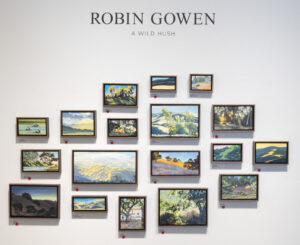 2019: what a year! The art and design world CHANGED that year, and we thought it had changed forever. More of us want to forget the year 2019 because important changes happened to the consumer market for fine art and design. 2019 marked a watershed moment in the art world, especially at the end of 2019 as we learned of the impending lockdown.
2019: what a year! The art and design world CHANGED that year, and we thought it had changed forever. More of us want to forget the year 2019 because important changes happened to the consumer market for fine art and design. 2019 marked a watershed moment in the art world, especially at the end of 2019 as we learned of the impending lockdown.
The dust still hasn’t settled on the trends begun during the pandemic, namely that most of the buying public purchased fine art and great design online. High-end collectors, who often spend more money than you and me, learned to use the big auction house websites. If they didn’t purchase online themselves, collectors of great art and furniture hired experts. The galleries that continued to serve collectors, like our wonderful and resilient Sullivan Goss, showed their strength and kept their clients during this highly turbulent period.
Five plus years later… In mid-2025, things have again changed. The forced, insular nature of the “lockdown” taught us a harsh lesson. The sheer number of online sales from home offices and dining room tables 2020-2023 created a new asset class: art and high-end design purchased not so much for pleasure or status but for investment purposes, similar to a purchase of stock in a hot corporation.
In mid-2025, things have again changed. The forced, insular nature of the “lockdown” taught us a harsh lesson. The sheer number of online sales from home offices and dining room tables 2020-2023 created a new asset class: art and high-end design purchased not so much for pleasure or status but for investment purposes, similar to a purchase of stock in a hot corporation.
A recent report by Artnet News predicts the art market may return, as we progress through 2025, to more traditional art and traditional values. Those values are becoming less financial, more about the purchases of traditionally classic art.
In summary, art as an “industry” isn’t the primary focus of the art world in mid-2025. Money isn’t the primary determinant of the value of a work of art as I write this newsletter, according to the databases that track trends and sales. Leading indicators are those facts, figures, and trends sourced from Christie’s, Sotheby’s, and Bonhams-Skinner, as well as smaller auction houses, galleries and dealers, including tastemakers in the art world.
Fascinating trends mid-year 2025; a year of a reversal of trends set back in 2019: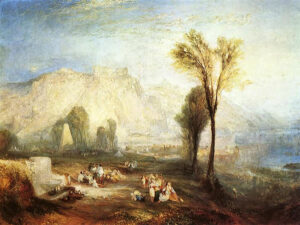 Fine art sales at auction are down approximately ten percent compared to this time last year. Collectors, likewise, pay at ten percent LESS for a work of art.Next Gen buyers as well as seasoned collectors pressed pause on purchases of hot new fashionable art. They now focus on those works with a solid record of accomplishment, such as Modern Masters—those names we all know.The fastest growing trend is the purchase of “Old Master” works of art—big names of the 17th through 19th centuries in painting, drawing, and sculpture. “Classic” works of art sales rose twenty-five percent over last year’s sales. For example, Christie’s NY in November will sell the collection of luxury resort tycoon Elaine Wynn. The collection is expected to fetch over $75 million. The earliest painting in the collection is also one of its highest-estimated lots. Joseph Mallord William Turner’s Ehrenbreitstein, or The Bright Stone of Honour and Tomb of Marceau from Byron’s Childe Harold, estimated at up to $18 million.The ultra-contemporary market, which includes works by young and fashionable “art stars” is down thirty percent as collectors want reliable track records of a work’s value, and make less “trophy” purchases.Art, once seen as a reason to pay millions, is now seen as an arena for ALL collectors. Great leaders of the art world, such as the retired head of the Guggenheim, Mariet Westermann, suggests museums might begin to share their entire collections, “like some of us share Ubers,” quoted in Artnet News, September 2025.The world is becoming more conservative and less speculative.
Fine art sales at auction are down approximately ten percent compared to this time last year. Collectors, likewise, pay at ten percent LESS for a work of art.Next Gen buyers as well as seasoned collectors pressed pause on purchases of hot new fashionable art. They now focus on those works with a solid record of accomplishment, such as Modern Masters—those names we all know.The fastest growing trend is the purchase of “Old Master” works of art—big names of the 17th through 19th centuries in painting, drawing, and sculpture. “Classic” works of art sales rose twenty-five percent over last year’s sales. For example, Christie’s NY in November will sell the collection of luxury resort tycoon Elaine Wynn. The collection is expected to fetch over $75 million. The earliest painting in the collection is also one of its highest-estimated lots. Joseph Mallord William Turner’s Ehrenbreitstein, or The Bright Stone of Honour and Tomb of Marceau from Byron’s Childe Harold, estimated at up to $18 million.The ultra-contemporary market, which includes works by young and fashionable “art stars” is down thirty percent as collectors want reliable track records of a work’s value, and make less “trophy” purchases.Art, once seen as a reason to pay millions, is now seen as an arena for ALL collectors. Great leaders of the art world, such as the retired head of the Guggenheim, Mariet Westermann, suggests museums might begin to share their entire collections, “like some of us share Ubers,” quoted in Artnet News, September 2025.The world is becoming more conservative and less speculative.Here are some auctions happening on Artnet. The titles of the auctions reflect this trend of more conservative directions:
 20th Century Art Live Now
20th Century Art Live NowThis auction showcases the evolution of art throughout the 20th century, highlighting the ways artists reacted to, and found inspiration in their predecessors and the world around them.GEMS: Collecting Post-War Abstraction
A marquee auction showcasing Post-War Abstraction and Colorfield painting. This auction offers vibrant paintings and works on paper—a nod to the founding movement of Modern Art in America.Museum Grade: Photographs and Prints
September photographs auction highlights the achievements of artists who currently exhibit in the world’s most prestigious public institutions. And Premier Prints & Multiples: Biggest prints sale of the season showcases works by some of the most popular artists on the market, from striking Pop pieces to bold street art.
The post BIG Changes in the Art World appeared first on Elizabeth Appraisals.
September 9, 2025
A Different Eagle Full of Symbolism
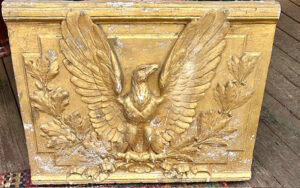 KC sent me a “relief” three-dimensional image of an eagle. This work created out of plaster, a plaque, boxed in the image on three sides measures seventeen by twenty-eight inches. KC found it in the basement of an antique dealer years ago.
KC sent me a “relief” three-dimensional image of an eagle. This work created out of plaster, a plaque, boxed in the image on three sides measures seventeen by twenty-eight inches. KC found it in the basement of an antique dealer years ago.
Instead of the typical spread-wing eagle associated with American iconography, KC’s eagle shows wings pointing straight up, similar to those in Roman Classical design. Instead of the typical American symbols of the olive branch in the dexter, right talon, and arrows in the sinister, left talon, this eagle holds the olive branch in the sinister and an oak branch in the dexter talon. American bald eagles on coins, the Great Seal designed in 1782, architecture, and Federal furniture feature a stars and stripes shield over the eagle’s breast.
KC’s eagle IS DIFFERENTWhat’s the eagle’s origin? The key to KC’s eagle is the symbol of the eagle itself, representing kings, power, and the status quo. This goes back to Greek mythology in the eagle of Zeus, and later in Roman times, the symbol of Jupiter, the King of the Gods, as his eagle, his messenger, or incarnation. Charles Thomson, American Secretary of the Continental Congress in 1782 modified this Classical eagle iconography to feature the bald eagle, a true American native species, for the Great Seal.
We find animal images used as symbols of strength in many mythologies. I mentioned the eagles of Zeus and Jupiter. There‘s also Ibis of Thoth in Egyptian culture. In Hinduism there’s the eagle-man Garuda, and Ganesha, the god with the elephant head.
Animals Symbolize Certain AttributesFor millennia the eagle represented kingship, dominion, strength, power, wealth and majesty. In the 17th and 18th century the eagle meant the power of money, thus the symbol’s incorporation in money, symbolizing financial power. Also used in a family crest (heraldry). Eagle images were used in Europe and America on architecture that represented national wealth, family wealth, and banking.
KC’s eagle, with its oak and olive branches, most resembles eagles associated with banking and financial institutions. The symbol of the oak tree represents solidity. The olive branch symbolizes peace. When associated with money, the images mean wealth and stability.
The American dime of the late 19th century features both the olive and the oak branch. Although these two symbols aren’t paired with an eagle, but with a torch on our ten cent coin. The olive branch is seen on the left of the torch.
I found a similar eagle, with an olive and oak branch, and upright wings in the Roman style, on French and American architecture and objects associated with banking of the 19th century. French banks of the period bore emblems of both the oak and the olive branch, with or without an eagle symbol.
The French Eagle ConnectionThe connection between the eagle of French monetary symbolism, and the American monetary symbolism are close cousins. Congress debated the establishment of the US National Bank as an institution for our young country 1789-1801. History calls this the Federal Period because French and American finances became closely associated, for good and bad, profit and debt. The US borrowed greatly from France, and France demanded that debt repaid. Debate over banking and national debt waged between American French supporters and isolationists. In 1795 the US settled its French debt and begun in earnest our own National Bank.
KC’s eagle was designed in relief on plaster which means this plaque was part of a wall or building, thus, incorporated into architecture. Perhaps once an emblem of a bank. I surmise they didn’t create it for an American bank. Plaster was used for exterior decorative elements throughout the 19th century, and I assume this created in the mid to late 19th century with a European origin.
KC, I can’t give you a value on this plaque, but I postulate $500-ish. We’ve uncovered these details: it’s most likely French and associated with banking, It served as part of a structure as a decorative object, and it symbolized solidity, power, and stability.
The post A Different Eagle Full of Symbolism appeared first on Elizabeth Appraisals.
September 6, 2025
Nomad Tango Presents Malena
Nomad Tango Executive Director Alejandra Folguera joins choreographer and dancer Fernanda Ghi to talk about the production of Malena—the story of a woman’s rebellion and her fight to claim her freedom at the Lobero Theatre on Saturday, September 6.
Watch Video

The post Nomad Tango Presents Malena appeared first on Elizabeth Appraisals.
Elizabeth Stewart's Blog
- Elizabeth Stewart's profile
- 5 followers



